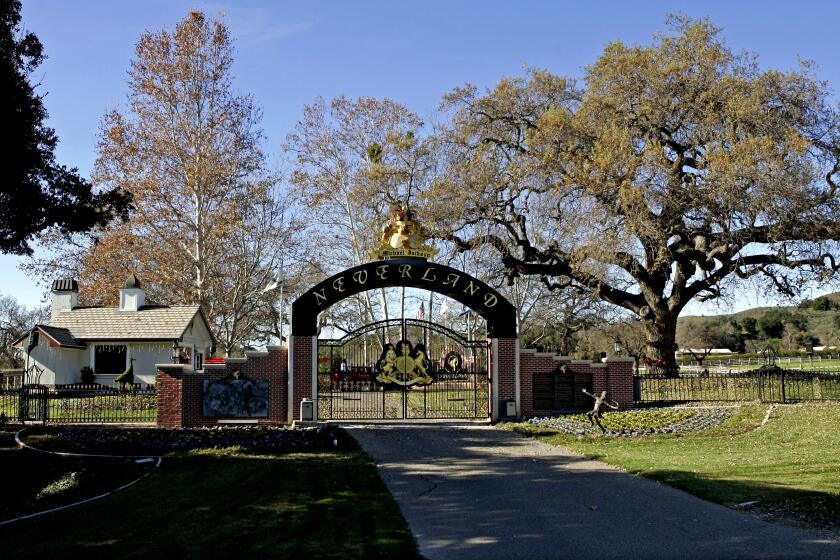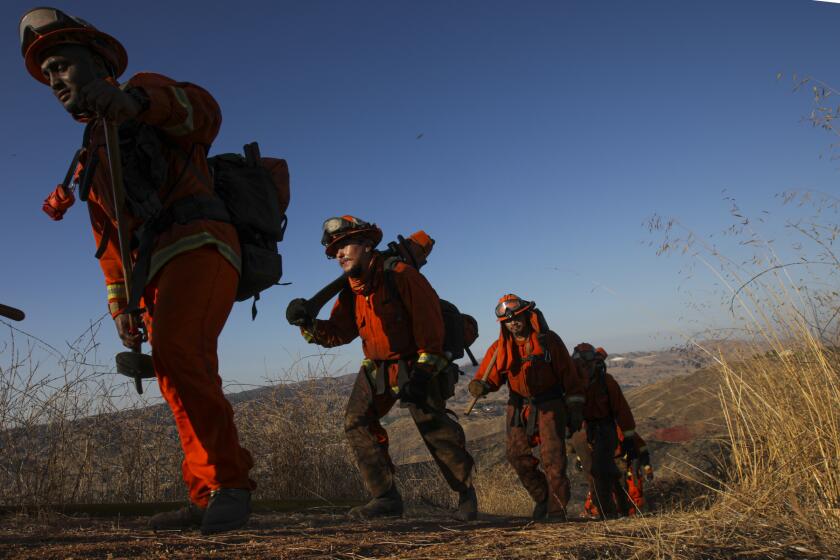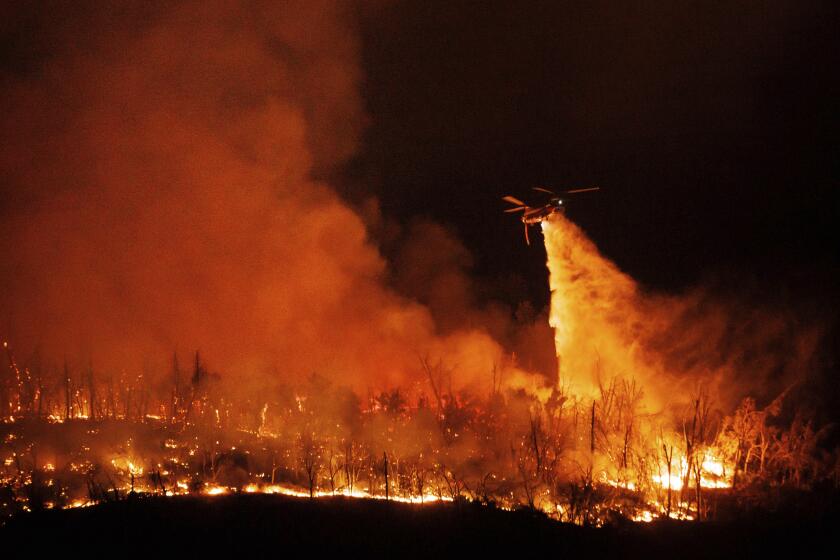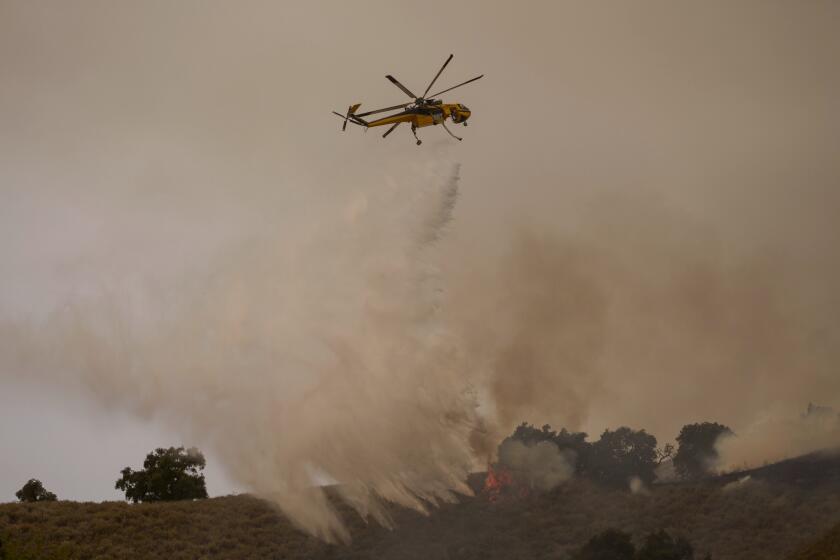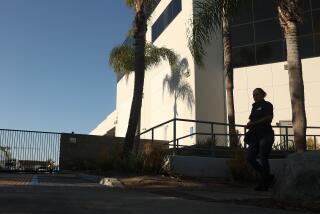
When a wildfire started in the mountains of Fresno County late last month, much of California was on the cusp of a heat wave that would go on to smash records both for its intensity and duration. Over the next week and a half, as the Basin fire swelled to more than 14,000 acres and temperatures in the area reached 112 degrees, at least nine firefighters were treated for heat-related illness. Four were taken to local hospitals, three of them airlifted from the fire line.
As the heat wave stretched on, the incident management team overseeing the fire formed a working group to deal with the extreme conditions. They provided firefighters with electrolytes to add to their drinking water and cooling towels to place on their necks.
And on July 5, in what may have been a first in the state, they constructed five generator-powered, air-conditioned yurts ‚ÄĒ three out on the fire line and two at the incident command post ‚ÄĒ to be used as emergency cooling stations.
Aggressive and impactful reporting on climate change, the environment, health and science.
‚ÄúI‚Äôve been doing this for over 35 years, and I can tell you that I have never seen this done before,‚ÄĚ said Mike Lindbery of the U.S. Forest Service, public information officer on the Basin fire. ‚ÄúThe heat has caused this team, which is basically coming in to solve problems, to look at a different aspect of problem solving.‚ÄĚ
Much attention has been paid to the ways in which extreme heat ratchets up the risk of wildfire and intensifies its behavior, resulting in longer, more destructive fire seasons. But perhaps just as vexing are the challenges heat poses to the health of firefighters themselves, who already perform backbreaking work saddled with heavy equipment in unforgiving terrain.
On Tuesday, Daniel Foley, 27, a first-year Forest Service firefighter assigned to the Bly Ranger District in Oregon’s Fremont-Winema National Forest, collapsed after completing a fitness test and died at a local hospital. It’s not yet clear whether heat was a factor. The area was under a heat advisory, with afternoon temperatures in the mid-80s to 90s, depending on the elevation, according to the National Weather Service.
‚ÄúIt‚Äôs one of the hottest years on record for me so far, that I can remember,‚ÄĚ said Mike Noel, assistant director of risk management for the Forest Service‚Äôs Pacific Southwest Region. He has been a wildland firefighter for 38 years. ‚ÄúAll agencies have had multiple heat-related injuries this year.‚ÄĚ
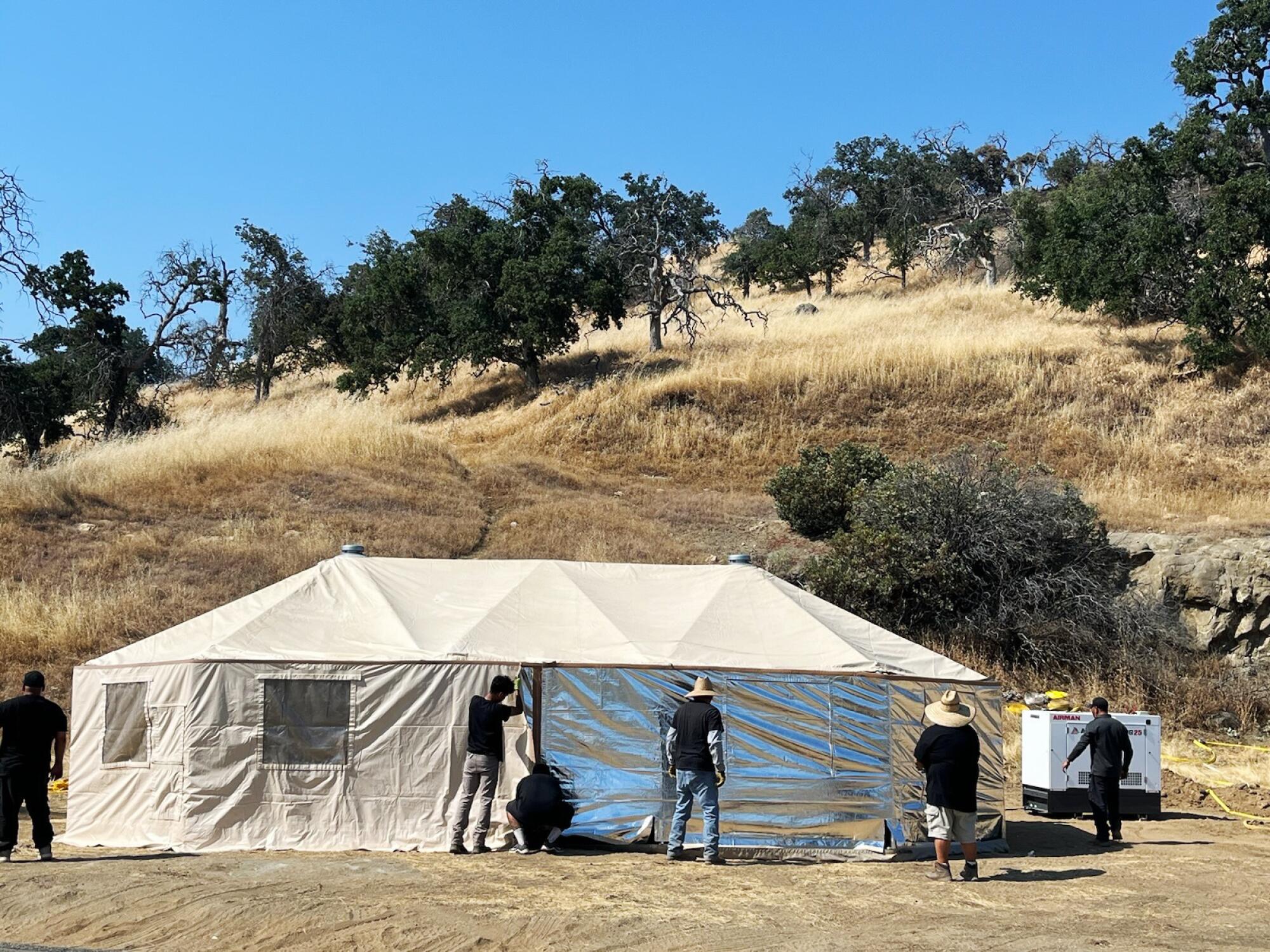
California has seen an uptick in heat-related illness among firefighters over the last 10 days or so coinciding with the elevated temperatures, he said. Seven firefighters assigned to the Lake fire in Santa Barbara County were treated for such illnesses on Thursday alone, he said.
At least four firefighters suffered from heat-related illness while fighting the Thompson fire in Butte County on July 2, and at least one on the Sharp fire in Ventura County on July 3, according to public information officers for those fires.
‚ÄúThis is extreme heat throughout the West, and it‚Äôs possible whole crews are being affected,‚ÄĚ said Timothy Ingalsbee, former wildland firefighter and executive director of nonprofit Firefighters United for Safety, Ethics, and Ecology.
Wildland firefighters wear about 50 pounds of personal protective equipment, including a helmet, safety goggles and a personal pack containing water and equipment, said David Acuna, battalion chief of communication for the southern region of the California Department of Forestry and Fire Protection.
They may also carry a 25-pound hose pack, as well as hand tools like chain saws or nozzles. And they often must hike to remote locations and then perform physical labor once they get there, which can include digging fire lines, putting in hose lays and taking vegetation down to bare mineral soil to stop the fire spread ‚ÄĒ all as they breathe in smoke, dust and debris.
‚ÄúIt‚Äôs claustrophobic, sometimes, because it seems like you can‚Äôt escape from the heat and smoke,‚ÄĚ Acuna said.
Cal Fire firefighters typically work 24-hour shifts, followed by 24 hours off in order to rest and refuel, he said. During those 24 hours on, breaks can be elusive. ‚ÄúIf we can catch a quick cat nap in the engine, that‚Äôs great, but most of the time we stay engaged,‚ÄĚ he said.
Neverland Ranch, the former home of pop sensation Michael Jackson, was threatened this week as the Lake fire continued to burn in Santa Barbara County.
Breaks were once openly frowned upon ‚ÄĒ ‚Äúit‚Äôs that tough, macho culture,‚ÄĚ said Riva Duncan, former wildland firefighter and vice president of Grassroots Wildland Firefighters, an advocacy group made up of retired and current federal firefighters.
But for many, a wake-up call came in 2011, when Bureau of Land Management firefighter Caleb Hamm, 23, died from exertional heatstroke on a fire in Texas, becoming just the second reported federal wildland firefighter to do so. A U.S. Centers for Disease Control and Prevention report with recommendations for better protecting firefighters was widely distributed.
The incident raised awareness among superintendents, crew leaders and engine captains about early indicators of heat illness, and encouraged firefighters to speak up when they’re not feeling well, Duncan said. Many crews now have EMTs who carry extra electrolytes and cooling blankets and are trained to spot the early warning signs of heat illness, which can include cramps, weakness, nausea and fatigue, she said.
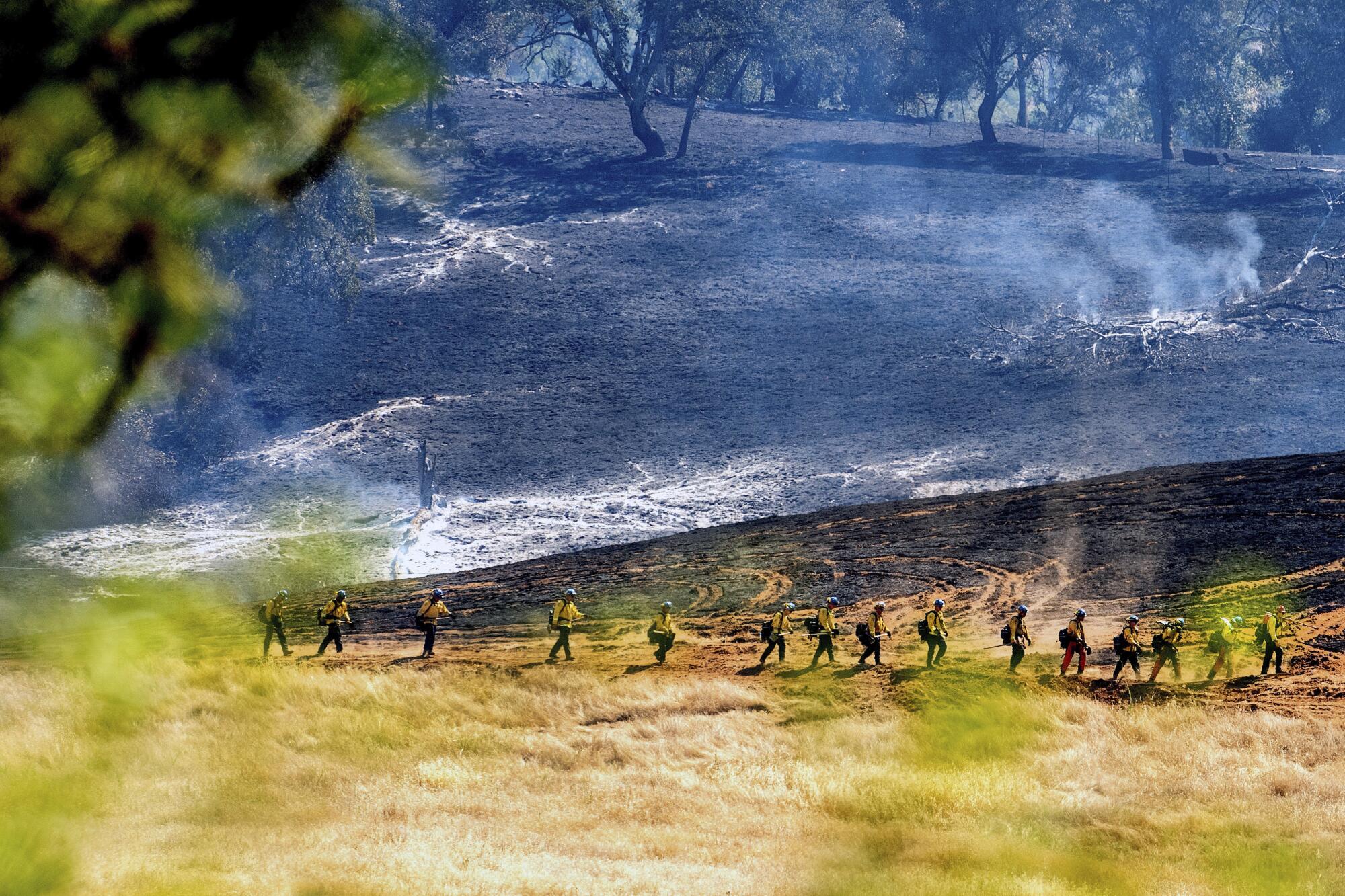
Still, climate change has resulted in an ever-shifting baseline for what conditions firefighters can expect, including more intense, longer-lasting heat waves.
‚ÄúWe‚Äôre not even at the halfway mark in July,‚ÄĚ Duncan said. ‚ÄúThese extreme heat situations started early.‚ÄĚ
‚ÄúPeople need to understand that fires are behaving differently than they used to,‚ÄĚ she added. ‚ÄúIt‚Äôs not easy to put them out because they‚Äôre burning under different conditions than 10, 15 years ago.‚ÄĚ
In California, as of Friday, 3,630 wildfires had burned 228,756 acres, compared with a five-year average of 3,743 fires and 111,813 acres over the same time frame, Acuna said.
‚ÄúThe fires are much, much more aggressive,‚ÄĚ he said, attributing this to the heat and dryness, as well as the abundance of grasses and other fuels, which were stoked by two wet winters and left largely untouched by two mild fire seasons.
The inmate workforce performs critical fuel-reduction projects year-round and are at times in the path of fires.
Members of the Redding Hotshots, an elite crew of Forest Service firefighters, are used to dealing with sweltering summer heat. But this season has been punishing even by their standards. They recently fought fires in both the Tahoe and Modoc national forests, where temperatures were in the 100s.
‚ÄúIt‚Äôs always hot on fires, but it seems like this year so far has definitely been about dealing with temperatures over 100, if not more,‚ÄĚ said hotshot superintendent Dan Mallia.
Forest Service fire crews typically work up to 16-hour shifts, followed by eight hours of rest that are often spent sleeping outside. Although Mallia said breaks can be hard to come by, depending on how a fire is behaving, he says he encourages his members to hydrate, eat well and find shade when they can.
He noted that crews acclimate to the heat by training in it, but that it’s difficult to fully prepare for such extreme conditions.
‚ÄúAt the end of the day when you get out on a fire, it‚Äôs a little different,‚ÄĚ he said. ‚ÄúThere‚Äôs a lot of stuff going on as far as the work, the stress, the smoke, the heat, the fire ‚ÄĒ all that stuff definitely ramps up.‚ÄĚ
Complicating matters, wildland firefighters are often sent to work in unfamiliar areas, which can make them feel the effects of extreme heat more acutely, said Max Alonzo, national business representative for the National Federation of Federal Employees and a former wildland firefighter who worked for the Forest Service for most of his career.
‚ÄúI have seen people really struggle when they show up to different climates and different topography that they‚Äôre not used to, where they‚Äôre not used to the elevation, they‚Äôre not used to the weather,‚ÄĚ he said. ‚ÄúWe‚Äôre a national resource, so they‚Äôre going to go all over the country.‚ÄĚ
He said that agencies could do more to proactively protect firefighters from the heat, including erecting cooldown areas on fire lines. Although he applauded the use of cooling yurts on the Basin fire, he said it‚Äôs not normal practice. Normal would be, ‚ÄúHey, make sure you tell people to stay hydrated,‚ÄĚ he said.
More could also be done to alternate crews ‚ÄĒ pulling firefighters off the line and letting them cool down before moving them back in, he said.
Butte County has been buffeted by disaster after disaster in recent years. But the Camp fire, California’s deadliest wildfire to date, left deep wounds.
Cal Fire has already made changes to its personal protective equipment in response to rising temperatures, including transitioning to single-layer pants and removing colored ink from wildland jackets and undershirts in response to evidence that it increased the heat levels of the firefighters wearing them.
Federal agencies and many state and municipal departments have also begun to use drones to scout ahead of a fire or ignite backfires, lessening the burden on firefighters who would otherwise have to hike in on foot.
And wildland firefighters in hotter climates sometimes work bimodal shifts ‚ÄĒ toiling in the morning hours, then pulling back during the heat of the day and getting back out as things cool down in the evening, Mallia said.
Still, some say more changes may be necessary as the planet continues to warm. That could include sending more firefighters to an incident so they can distribute the workload more evenly, or placing more emphasis on nighttime operations.
The conditions also illustrate the increasing prudence of managing some backcountry fires for ecological benefit, treating them more like controlled burns rather than trying to immediately suppress them, Duncan said. That benefits the environment, and it protects the physical health of firefighters by permitting them to focus on fires threatening people or structures, she said. The idea remains politically unpopular, she noted.
It will also be increasingly key to set more controlled fires in the spring and fall to reduce the amount of fuel on the ground come summer, Ingalsbee said.
‚ÄúBig picture, we‚Äôre going to have to be proactively managing fire during the cooler period of the year, rather than attacking all fires at the hottest period of the year, when we fail, and we surpass human physical ability for working in these kinds of conditions,‚ÄĚ he said.
One thing appears certain: These conditions are unlikely to improve.
‚ÄúI got a desperate call this morning from one of our members just like, ‚ÄėWhen is this going to end?‚Äô ‚ÄĚ he said Wednesday. ‚ÄúThe heat is not ending. We‚Äôre just going to have to adapt to the new normal, whatever that is.‚ÄĚ
California’s fire season is off to a fierce start. Here’s the latest on the season to date, including the nearly 20 fires burning in the state.

